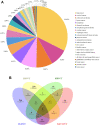Solid Tumor Complicated With Venous Thromboembolism: A 10-Year Retrospective Cross-Sectional Study
- PMID: 33591842
- PMCID: PMC7894580
- DOI: 10.1177/1076029620975484
Solid Tumor Complicated With Venous Thromboembolism: A 10-Year Retrospective Cross-Sectional Study
Abstract
Venous thromboembolism (VTE), including pulmonary embolism (PE) and deep vein thrombosis (DVT) occurs more frequently in cancer patients than in the general population. A retrospective cross-sectional study was carried out in patients with solid tumor complicated with VTE admitted to the Cancer Center, Union Hospital, Tongji Medical College, Huazhong University of Science and Technology between January 1st, 2008 and December 31th, 2017. The incidence of VTE in hospitalized cancer patients was 1.8%, twice the incidence of VTE in hospitalized non-cancer patients. The annual incidence of cancer-associated VTE in our center varied between 1.6% in 2015 and 0.4% in 2009 with an overall average incidence of 1.3% over the research decade. BMI values of 549(67.7%) cancer patients were within the normal range, but none of patients had BMI greater than 35 kg/m2. 747(92.1%) cancer patients had ECOG PS score ≤ 2 and 481(59.3%) had distant metastasis. Patients with pancreatic, bladder, ovarian and endometrial cancer had the highest incidence of VTE. Upper extremity DVT (47.2%) was more common in cancer patients and might be closely associated with CVC (74.9%), while lower extremities DVT (36.1%) intended to PE development (15.0%). The annual incidence rates showed a fluctuating and upward trend over the research decade. VTE occurrence was closely related to tumor stage, tumor site, catheterization and anti-neoplasm therapy in cancer patients.
Keywords: DVT; PE; VTE; cancer; pulmonary embolism; venous thromboembolism.
Conflict of interest statement
Figures

Similar articles
-
Venous thromboembolism: deep venous thrombosis and pulmonary embolism in a neurosurgical population.J Neurosurg. 2011 Jan;114(1):40-6. doi: 10.3171/2010.8.JNS10332. Epub 2010 Sep 3. J Neurosurg. 2011. PMID: 20815694
-
High Prevalence and Mortality Associated with Upper Extremity Deep Venous Thrombosis in Hospitalized Patients at a Tertiary Care Center.Ann Vasc Surg. 2020 May;65:55-65. doi: 10.1016/j.avsg.2019.10.055. Epub 2019 Oct 24. Ann Vasc Surg. 2020. PMID: 31669473
-
Incidence and Clinical Characteristic of Venous Thromboembolism in Gynecologic Oncology Patients attending King Chulalongkorn Memorial Hospital over a 10 Year Period.Asian Pac J Cancer Prev. 2015;16(15):6705-9. doi: 10.7314/apjcp.2015.16.15.6705. Asian Pac J Cancer Prev. 2015. PMID: 26434898
-
[Clinical features of patients with venous thromboembolism: 177 case analysis in 10 years].Zhonghua Wei Zhong Bing Ji Jiu Yi Xue. 2019 Apr;31(4):453-457. doi: 10.3760/cma.j.issn.2095-4352.2019.04.016. Zhonghua Wei Zhong Bing Ji Jiu Yi Xue. 2019. PMID: 31109420 Review. Chinese.
-
Venous thromboembolism in cancer and cancer immunotherapy.Crit Rev Oncol Hematol. 2022 Oct;178:103782. doi: 10.1016/j.critrevonc.2022.103782. Epub 2022 Aug 10. Crit Rev Oncol Hematol. 2022. PMID: 35961476 Review.
Cited by
-
Integrated Analysis of Microbiome and Transcriptome Data Reveals the Interplay Between Commensal Bacteria and Fibrin Degradation in Endometrial Cancer.Front Cell Infect Microbiol. 2021 Sep 21;11:748558. doi: 10.3389/fcimb.2021.748558. eCollection 2021. Front Cell Infect Microbiol. 2021. PMID: 34621695 Free PMC article.
-
Derivation, validation and assessment of a novel nomogram-based risk assessment model for venous thromboembolism in hospitalized patients with lung cancer: A retrospective case control study.Front Oncol. 2022 Oct 10;12:988287. doi: 10.3389/fonc.2022.988287. eCollection 2022. Front Oncol. 2022. PMID: 36300098 Free PMC article.
-
Prevalence and treatment of venous thromboembolism in patients with solid tumors.Exp Ther Med. 2022 Nov 3;24(6):743. doi: 10.3892/etm.2022.11679. eCollection 2022 Dec. Exp Ther Med. 2022. PMID: 36478882 Free PMC article.
-
Solid Tumors, Liquid Challenges: The Impact of Coagulation Disorders.Hematol Rep. 2025 Feb 5;17(1):8. doi: 10.3390/hematolrep17010008. Hematol Rep. 2025. PMID: 39997356 Free PMC article. Review.
-
Preoperative Systemic Immune-Inflammatory Index as a Predictive Biomarker for Lower Extremity Deep Vein Thrombosis after Breast Cancer Surgery: Stratified Nursing Intervention to Reduce Incidence.Med Sci Monit. 2023 Dec 17;29:e942087. doi: 10.12659/MSM.942087. Med Sci Monit. 2023. PMID: 38104239 Free PMC article.
References
-
- MacLellan DG, Richardson A, Stoodley MA. Venous thromboembolism and cancer. ANZ J Surg. 2012;82(5):294–298. - PubMed
-
- Nisio M, Di Nisio M, Ferrante N, et al. Incidental venous thromboembolism in ambulatory cancer patients receiving chemotherapy. Thromb Haemostas. 2010;104(11):1049–1054. - PubMed
-
- Lee AY, Levine MN. Venous thromboembolism and cancer: risks and outcomes. Circulation. 2003;107(23_suppl_1):I17–I21. - PubMed
-
- Schmaier AA, Ambesh P, Campia U. Venous thromboembolism and cancer. Curr Cardiol Rep. 2018;20(10):89. - PubMed
-
- Connors JM. Prophylaxis against venous thromboembolism in ambulatory patients with cancer. N Eng J Med. 2014. 370(26):2515–2519. - PubMed
MeSH terms
LinkOut - more resources
Full Text Sources
Other Literature Sources
Medical

